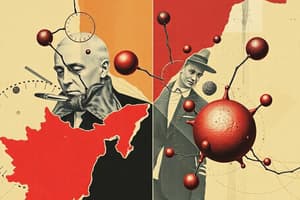Podcast
Questions and Answers
Which of the following statements best describes ionic bonds?
Which of the following statements best describes ionic bonds?
- Electrons are shared between atoms.
- They result in liquid or gaseous compounds at room temperature.
- Electrons are transferred from one atom to another. (correct)
- Ionic bonds usually form between nonmetals.
Covalent compounds can conduct electricity.
Covalent compounds can conduct electricity.
False (B)
What type of elements typically form covalent bonds?
What type of elements typically form covalent bonds?
Nonmetals
Ionic compounds usually consist of a metal and a ______.
Ionic compounds usually consist of a metal and a ______.
Match the type of bond with its characteristic:
Match the type of bond with its characteristic:
Which statement correctly describes an ionic bond?
Which statement correctly describes an ionic bond?
Cations are formed when nonmetals gain electrons.
Cations are formed when nonmetals gain electrons.
What is an anion?
What is an anion?
A charged atom or molecule is known as an ______.
A charged atom or molecule is known as an ______.
Match the following terms with their definitions:
Match the following terms with their definitions:
What type of bond involves sharing electrons?
What type of bond involves sharing electrons?
Covalent bonds typically form between metals.
Covalent bonds typically form between metals.
Name one example of a polyatomic ion.
Name one example of a polyatomic ion.
What type of ions are formed when metals lose valence electrons?
What type of ions are formed when metals lose valence electrons?
Nonmetals gain electrons to form positive ions.
Nonmetals gain electrons to form positive ions.
When metals lose electrons, they become ________ ions.
When metals lose electrons, they become ________ ions.
Which of the following describes the process when nonmetals gain electrons?
Which of the following describes the process when nonmetals gain electrons?
Ionic bonds are formed between two metals.
Ionic bonds are formed between two metals.
The attractive forces that hold atoms together in molecules or formula units are known as ________ bonds.
The attractive forces that hold atoms together in molecules or formula units are known as ________ bonds.
Match the following descriptions with the correct terms:
Match the following descriptions with the correct terms:
Flashcards
Covalent Bond
Covalent Bond
A chemical bond formed by the sharing of electrons between atoms.
Ionic Bond vs. Covalent Bond
Ionic Bond vs. Covalent Bond
Ionic bonds involve electron transfer, while covalent bonds involve electron sharing; both lead to stable compounds.
Covalent Compound
Covalent Compound
A compound formed through covalent bonding between nonmetals, often having low melting and boiling points.
Octet Rule
Octet Rule
Signup and view all the flashcards
Valence Electrons
Valence Electrons
Signup and view all the flashcards
What are ionic bonds?
What are ionic bonds?
Signup and view all the flashcards
What forms a cation?
What forms a cation?
Signup and view all the flashcards
What forms an anion?
What forms an anion?
Signup and view all the flashcards
What are covalent bonds?
What are covalent bonds?
Signup and view all the flashcards
What is a polyatomic ion?
What is a polyatomic ion?
Signup and view all the flashcards
What is a monoatomic ion?
What is a monoatomic ion?
Signup and view all the flashcards
What are valence electrons?
What are valence electrons?
Signup and view all the flashcards
What is the octet rule?
What is the octet rule?
Signup and view all the flashcards
Metals + Bonding
Metals + Bonding
Signup and view all the flashcards
Why do metals lose electrons?
Why do metals lose electrons?
Signup and view all the flashcards
Nonmetals + Bonding
Nonmetals + Bonding
Signup and view all the flashcards
Why do nonmetals gain electrons?
Why do nonmetals gain electrons?
Signup and view all the flashcards
Cations
Cations
Signup and view all the flashcards
Anions
Anions
Signup and view all the flashcards
Chemical Bond
Chemical Bond
Signup and view all the flashcards
What is a chemical bond?
What is a chemical bond?
Signup and view all the flashcards
Study Notes
Chemical Bonds
- Chemical bonds are attractive forces holding atoms together in molecules or formula units.
- Electrons experience a force of attraction from both nuclei, creating a negative-positive-negative attraction.
- This attraction holds the particles together.
- The attraction is called a chemical bond.
- A pair of electrons form a bond.
Ions
- An ion is an atom or group of atoms that has lost or gained electrons.
- Metals lose electrons to form positive ions (cations).
- Nonmetals gain electrons to form negative ions (anions).
- Ions have a positive or negative charge due to unequal numbers of electrons and protons.
Types of Chemical Bonds
-
Ionic bonds: Attractive forces between oppositely charged ions.
- Involve the transfer of electrons between a metal and a nonmetal.
-
Covalent bonds: Sharing of electrons between atoms, typically between nonmetals.
- These atoms do not form ions.
Types of Ions
-
Monoatomic ions: Single atoms with a charge. Examples: Na⁺, Cl⁻.
-
Polyatomic ions: Groups of atoms with an overall charge. Examples: SO₄²⁻, NH₄⁺.
Properties of Ionic and Covalent Compounds
| Feature | Ionic Compounds | Covalent Compounds |
|---|---|---|
| Formation | Metal + Nonmetal | Nonmetal + Nonmetal |
| Bonding | Transfer of electrons | Sharing of electrons |
| Structure | Crystal lattice structure | Molecular structure |
| Melting/Boiling Point | High melting and boiling points | Low melting and boiling points |
| State at room temp | Solid | Varies (solid, liquid, or gas) |
| Electrical Conductivity | Conduct electricity when dissolved in water | Do not conduct electricity in any state |
Studying That Suits You
Use AI to generate personalized quizzes and flashcards to suit your learning preferences.




